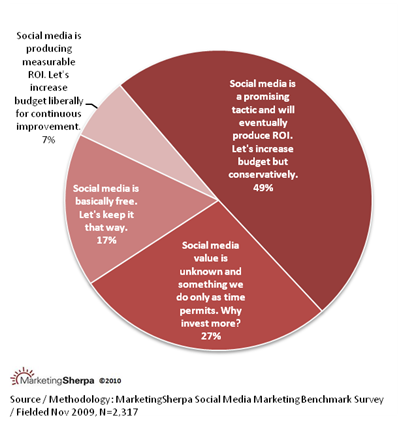Email Marketing: Show me the ROI
After squinting at my screen for weeks trying to read the MarketingSherpa 2011 Email Marketing Benchmark Report PDF, I finally have a hard copy sitting on my desk — and it’s bursting with insight.
Having read the executive summary weeks earlier, I flipped through the chapters today and was struck by this stat:
Does your organization have a method for quantifying ROI from email marketing?
- No: 59%
- Yes: 41%
Email marketing can be amazingly efficient. B2C marketers report an average 256% ROI from the channel — pulling in $2.56 for every $1 invested — as mentioned later in the report.
What shocks me is that 59% of email marketers have not gauged their program’s efficiency. This means their company executives are likely unaware of the amazing job they’re doing. Even if executives have seen the clickthrough and conversion rates, they’re likely thinking about that line from Jerry Maguire.
At last week’s Email Marketing Summit, Jeanne Jennings, Independent Consultant and MarketingSherpa Trainer, shot holes in many of the excuses she’s heard for why companies can’t calculate email’s ROI.
Here are three she highlighted:
- Our Web analytics software doesn’t provide this information
- We can’t track online sales back to email
- We don’t have an exact figure for costs
Taking these one at a time, Jennings noted that 1) most analytics solutions can provide the information. Google Analytics does and it’s free. 2) Setting up the tracking is simple. 3) You don’t need exact figures.
“As long as you can compare in an apples-to-apples fashion, that’s enough to get started,” Jennings said.
Judging performance by clickthrough and conversion rates is not enough — you should know the revenue generated, both on a campaign-level and a broader program-level.
Two simple calculations Jennings suggested:
- Return on investment: Net revenue / cost
- Revenue per email sent: Net revenue / # of emails sent
On a campaign-level, these metrics will reveal which campaigns pull in more money — not just more clicks. For your overall program, they quickly convey the importance of your work.
Also: The movers and shakers in your company are going to be much more impressed with figures that include dollar signs.
Show email’s potential
Another way to convince executives of email’s power is to point to success at other companies. Also at the Email Summit last week, Jeff Rohrs, VP, Marketing, ExactTarget, mentioned Groupon as a great example that email marketers could rally around.
Forbes recently dubbed the localized deal-of the-day website the fastest growing company ever, and its success is largely due to great email marketing.
The Wall Street Journal mentioned Groupon’s 50 million email subscribers as a competitive advantage and that some analysts estimate its value at $15 billion.
The executives will care
Once you can clearly attribute revenue and ROI to email, you might be surprised at how much attention you attract from company leaders.
At the Email Summit, Philippe Dore, Senior Director, Digital Marketing, ATP World Tour, presented his team’s email strategy to sell tickets to professional tennis events. A single email drove over $1 million in revenue, and several others brought in over $100,000 each.
The overall email campaign generated about $1.5 million in total. Suddenly, ATP’s executives were interested.
“We have our CMO talking about email marketing and subject lines,” Dore said.
Related resources
Email Marketing Summit 2011: 7 Takeaways to improve results
Email Marketing Awards 2011 Winners Gallery: Top campaigns and best results
Live Optimization with Dr. Flint McGlaughlin at Email Summit 2011
MarketingSherpa 2011 Email Marketing Benchmark Report
MarketingSherpa Email Essentials Workshop Training with Jeanne Jennings
Photo by: SqueakyMarmot










